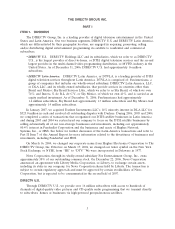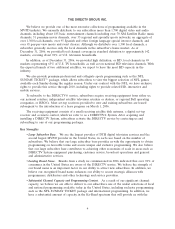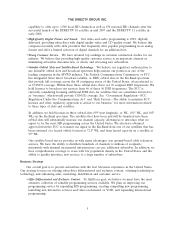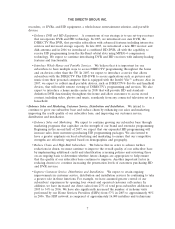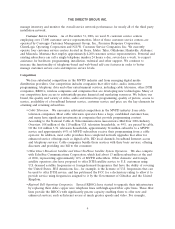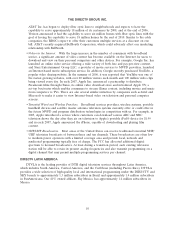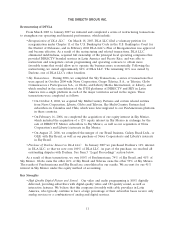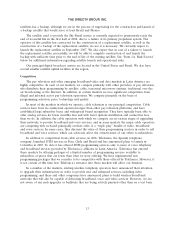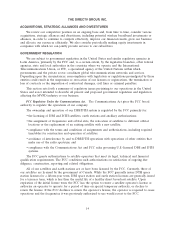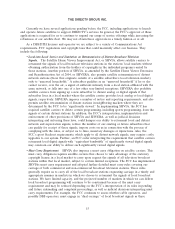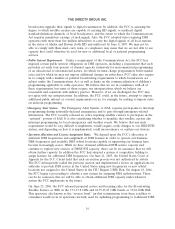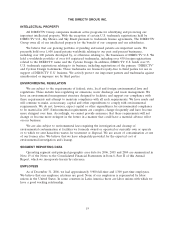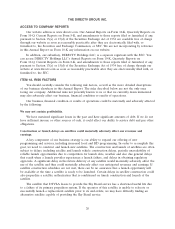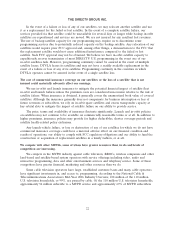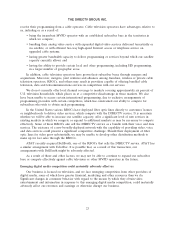DIRECTV 2006 Annual Report Download - page 24
Download and view the complete annual report
Please find page 24 of the 2006 DIRECTV annual report below. You can navigate through the pages in the report by either clicking on the pages listed below, or by using the keyword search tool below to find specific information within the annual report.THE DIRECTV GROUP, INC.
satellites has a backup, although we are in the process of negotiating for the construction and launch of
a backup satellite that would serve at least Brazil and Mexico.
The satellite used to provide the Sky Brazil service is currently expected to prematurely reach the
end of its useful life in the first half of 2008, due to a failure of its primary propulsion system. The
operator of this satellite has contracted for the construction of a replacement satellite, as well as the
construction of a backup of the replacement satellite, in case it is necessary. We currently expect to
launch the replacement satellite in September 2007. We also expect that in case of a failure to launch
the replacement satellite successfully, we will be able to complete construction of and launch the
backup with sufficient time prior to the end of life of the existing satellite. See ‘‘Item 1A. Risk Factors’’
below for additional information regarding satellite launch and operational risks.
Our principal digital broadcast centers are located in the United States and Brazil. We also have
several smaller satellite uplink facilities in the region.
Competition
The pay television and other emerging broadband video and data markets in Latin America are
highly competitive. In each of our markets, we compete primarily with other providers of pay television,
who distribute their programming by satellite, cable, terrestrial microwave systems, traditional over the
air broadcasting or the Internet. In addition, in certain markets we face significant competition from
illegal and informal sector pay television operations. We compete primarily on the basis of
programming selection, price, technology and quality.
In most of the markets in which we operate, cable television is our principal competition. Cable
services have been in commercial operation longer than other pay television platforms, and have
established large subscriber bases and widespread brand recognition. They have typically been able to
offer analog services for lower monthly fees and with lower upfront installation and connection fees
than we do. In addition, the cable operators with which we compete are in various stages of upgrading
their networks to provide broadband and voice services, and in some markets the major cable operators
are competing with us based principally on their offer of a ‘‘triple play’’ bundle of video, broadband
and voice services. In some cases, they discount the value of their programming services in order to sell
broadband and voice services, which can adversely affect the attractiveness of our offers to subscribers.
In addition to competition from cable services, in 2006, Telefonica, the Spanish telephone
company, launched DTH services in Peru, Chile and Brazil and has announced plans to launch in
Colombia in 2007. To date it has offered DTH programming services only to users of voice telephony
and broadband services provided by Telefonica’s affiliates in Latin America. Telefonica has entered
these markets by offering packages of a limited number of programming services available to
subscribers at prices that are lower than what we were offering. We have implemented new
programming packages that we consider to be competitive with those offered by Telefonica. However, it
is not certain at this time how Telefonica’s entrance into these markets will affect our business.
In a number of the markets, existing wireline telephony operators have announced their intention
to upgrade their infrastructure in order to provide new and enhanced services, including video
programming, and these and other companies have announced plans to build wireless broadband
networks that will also be capable of delivering broadband, voice and video services. However, we are
not aware of any such upgrades or buildouts that are being actively pursued other than on a test basis.
13


